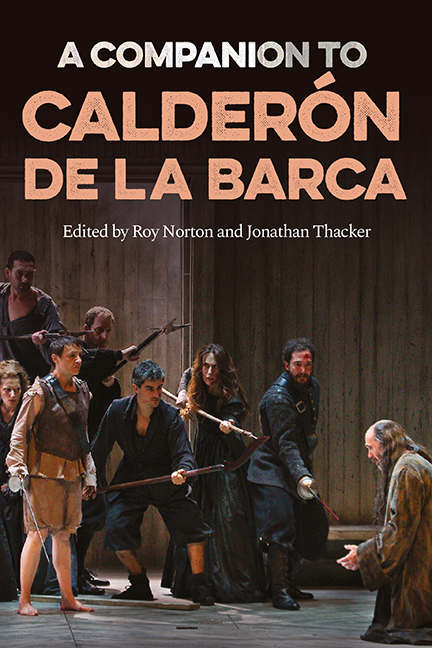Book contents
- Frontmatter
- Dedication
- Contents
- List of Illustrations
- List of Contributors
- Acknowledgements
- List of Abbreviations
- Introduction
- 1 Biography and Context
- 2 The Calderonian World
- 3 The Playwright’s Craft: Calderón and the Great Theatrical World of Early Modern Spain
- 4 La vida es sueño
- 5 The Honour Plays of Calderón
- 6 Calderón, the Comedian
- 7 Mythological Court Spectacle Plays
- 8 Religious comedias
- 9 Calderón’s ‘Sacramental, Allegorical and Historical’ autos
- 10 Calderón’s graciosos
- 11 Calderón and Visual Art
- 12 The Staging of Calderón’s Theatre
- 13 Calderón’s European Reception from Romanticism to the Twentieth Century
- 14 The Reception of Calderón in the Hispanic World
- Appendices
- Consolidated Bibliography
- Index
- Tamesis • Companions
11 - Calderón and Visual Art
Published online by Cambridge University Press: 07 October 2022
- Frontmatter
- Dedication
- Contents
- List of Illustrations
- List of Contributors
- Acknowledgements
- List of Abbreviations
- Introduction
- 1 Biography and Context
- 2 The Calderonian World
- 3 The Playwright’s Craft: Calderón and the Great Theatrical World of Early Modern Spain
- 4 La vida es sueño
- 5 The Honour Plays of Calderón
- 6 Calderón, the Comedian
- 7 Mythological Court Spectacle Plays
- 8 Religious comedias
- 9 Calderón’s ‘Sacramental, Allegorical and Historical’ autos
- 10 Calderón’s graciosos
- 11 Calderón and Visual Art
- 12 The Staging of Calderón’s Theatre
- 13 Calderón’s European Reception from Romanticism to the Twentieth Century
- 14 The Reception of Calderón in the Hispanic World
- Appendices
- Consolidated Bibliography
- Index
- Tamesis • Companions
Summary
In the fourth of his Diálogos de la pintura [Dialogues on Painting, 1633], as part of his exposition of the relationship between painting and poetry, Vicente Carducho praised seventeen contemporary poets and playwrights for their ‘painterly’ skills. Amongst those listed was a certain ‘don Pedro Calderon, feliz ingenio desta edad’ [Don Pedro Calderón, happy genius of this age]. Although other canonical writers receive more extensive praise – notably, both Luis de Góngora (d.1627) and, especially, the then septuagenarian Lope de Vega – the inclusion of the younger Calderón hints at the potential significance of painting in his works. In recent decades, as part of wider critical interest in intersection between the sister arts in early modern Spain, scholars have sought to shed light on his knowledge of visual art, his prox-imity to seventeenth-century artists, and the relevance of art, both theoretical and practical, to his drama(s). Critics from Manuel Ruiz Lagos, for whom ‘la tendencia hacia lo visual, hacia lo pictórico’ [inclination towards the visual, the pictorial] is central to Calderón's aesthetic, to Grace Burton, who contends that Calderón's most famous dramatic engagement with painting, the wife-murder play El pintor de su deshonra [The Painter of His Dishonour], is ‘not merely a play about painting’, but one ‘that is a painting’, have stressed the importance of visual art to an understanding of Calderón's work. Arresting claims, no doubt, but what substance lies behind these and other such contentions? What is actually known about Calderón and his links to the visual arts? What role do they play in his dramatic works? Ultimately, how much mileage is there in the oft-(mis)cited Horatian adage ut pictura poesis [as is painting, so is poetry] when applied to the dramatic verse of Calderón?
Two principal sources of documentary evidence attest to Calderón's much feted interest in art. The first, Deposición de d. Pedro Calderón de la Barca en favor de los profesores de la pintura [Deposition of Don Pedro Calderón de la Barca in Favour of Practioners of Painting], is a formal record, dated 8 July 1677, of the dramatist's expert testimony in a long-running legal battle between Madrid's professional painters and the tax authorities.
- Type
- Chapter
- Information
- A Companion to Calderón de la Barca , pp. 223 - 249Publisher: Boydell & BrewerPrint publication year: 2021



